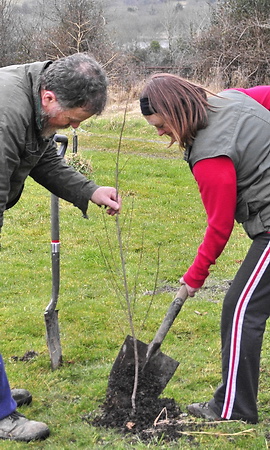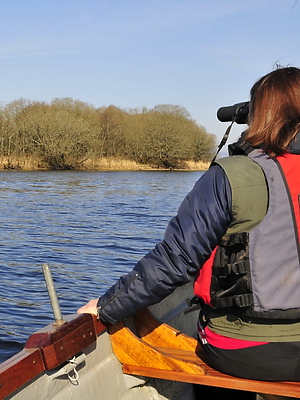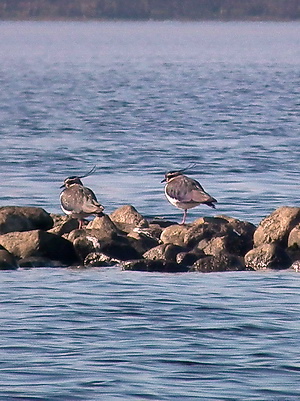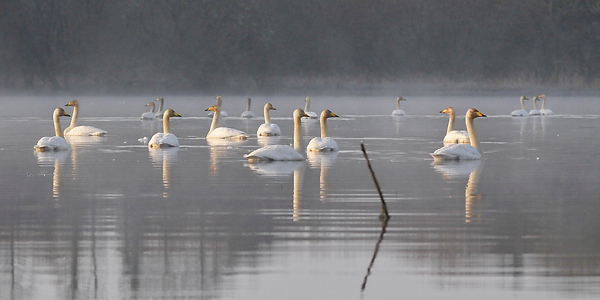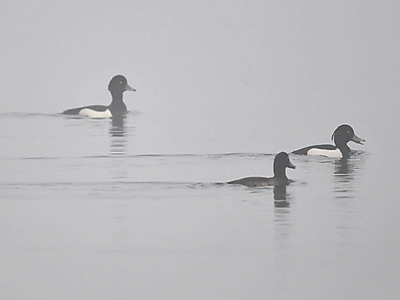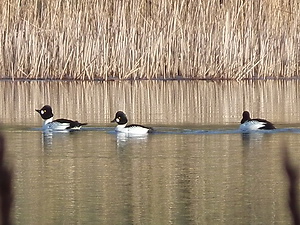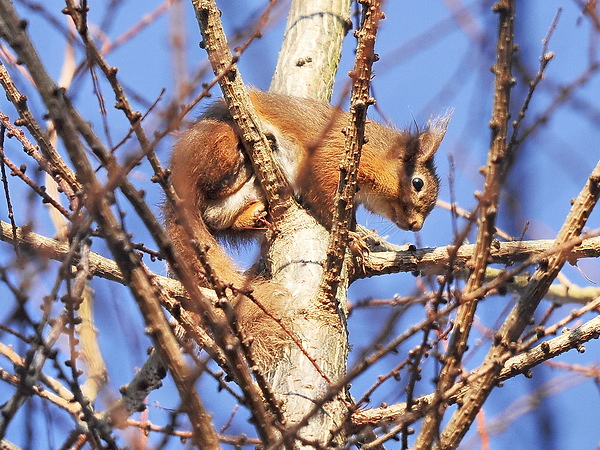|
- An occasional series of longer Reports and Studies -
“Spring around Lough Allen”
(2011)
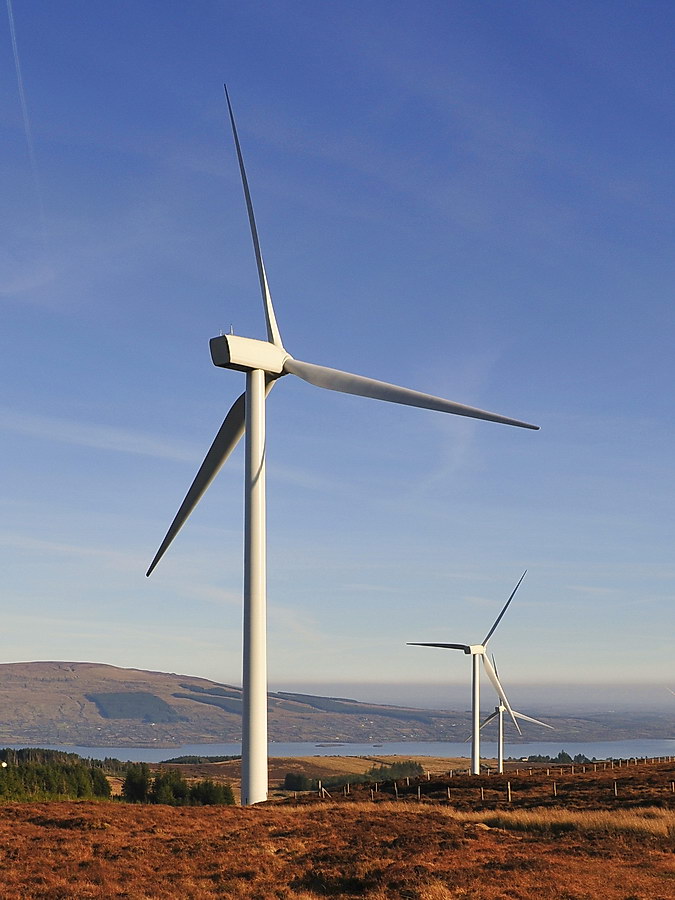 Topical issues and natural Topical issues and natural
events at this time of the year.
The New Year has settled, and (once again) Ireland is going through major change, and we have been struck by many and varied environmental issues. As always. our goal is to portray and conserve this beautiful place and also seek to attract more and better high tech employment. The changes going on in Ireland, as we write, hold out the potential for both good and harm to these twin endeavours.
Protecting the environment can create employment. New technological type employment can save our environment and its community. Here we use images to sell our place but also to highlight both natural changes that are going on around us and, also, the major pressing social changes. We would plead that now is not a time for inappropriate development or quick fixes that may solve current short term needs but leave us with less prospects and a poorer environment in the future.
The Windmill (on the left) symbolises energy! These beautiful and mighty symbols of a progressive Ireland stand high over Lough Allen. Energy concerns are a major interest to us all... and we try and suggest realistic plans and good environment/economic measures below.
Also, at this time, we are conscious (as always) of the need for more and better employment for our children. Many people are emigrating from this locality and it would be great if this became an option... not a necessity! Anyone who loves our country and our countryside must be aware that people are the most important part of any environment. So, as conservationists, we must always do our work conscious of the diverse needs of people in the community and this requires an openness of approach and an uncritical way of thinking. Those with a lack of balance may be responsible for the way they are perceived by the public, by displaying an excessive zeal and a narrow base in protecting what they cherish. Equally, people who presently live here have a responibility to sustain this place for themselves and for others. This is what we encapsulate in the idea of... social ecology!
The various topics we hope to cover in this Feature would include:
Energy and Lough Allen.
Tree Planting for Fuel and Nature.
Out and about in early Spring.
Springtime Bird Migration.
LAB work schedule for 2011.
Some of these topics are very large ones. We are lumping them together for pragmatic reasons. Many of these items were triggered by our recent General Election and the various meetings we had, or didn’t have, with the Politicians. We would be concerned with certain policies highlighted in terms of exploiting the environment and we have put forward cogent arguments to our 3 newly elected TDs (or their agents) as to how our energy needs (for example) might be better satisfied. These arguments are presented below. We don’t know how this debate is going to play out... hopefully positively!
1. Energy and Lough Allen:
One of Lough Allen Basin’s goals has always been to report and depict its plants and animal species of significance, or outstanding significance... and we have many of them. One of these species is the Marsh Fritillary. This is a charismatic Butterfly still found fairly widely around Ireland. But it is a species with very specific needs, shelter, food plant, suitable ‘nesting’ habitat. It is also parastised by Wasps and is best protected from wipe-out through such predation by having a number of small colonies distributed around the countryside and in contact with one another. This improves the chance of surviving parasitism. (More details on this Butterfly’s needs HERE.)
The ideal habitat for this species around Lough Allen is in the raised bogs found on the Roscommon shore of Lough Allen. These Bogs formed following the Ice Age where pools formed on the scoured out landscape and Sphagnum and other bog forming plants developed and built up thick layers of turf over thousands of years. This is a slow process and once the turf is removed and the bog forming species are destroyed, will never be repeated. Many of these derelict bog sites around the country highlight this waste.
Burn Wood.. not Bogs!
To protect these delicate habitats, which hold so much of our Heritage, we advocate another form of fuel harvesting from the Natural Environment. There are political, social and economic interests to be overcome if we are to successfully move our domestic fueling needs towrads this more sustainable form of annual harvesting! There are some strong interests involved, as there are in every vital area of life!
Comparison of Environmental Impact of Burning Wood v. Turf!
|
1.
|
Wood is a clean high calorific fuel.
|
|
Turf is a dirty, dusty, fuel, with a lot of Smoke.
|
|
2.
|
Wood is easier to harvest and store.
|
|
Turf is laborious to harvest and store.
|
|
3.
|
Forests are only temporarily damaged by felling.
|
|
Bogs can be destroyed through Turf cutting.
|
|
4.
|
Forests are world-wide. Irish coniferous forests are not native or ecologically valuable.
|
|
Raised Bogs are rare and particularly important in Ireland.
|
|
5.
|
Wood cutting is Carbon Neutral.
|
|
Cutting and Burning turf releases CO2.
|
|
6.
|
Forest are a renewable resource.
|
|
Raised Bogs can never be replaced and will not re-grow!
|
|
7.
|
The Lough Allen climate and rough land is ideal for forest growth.
|
|
Bogs are, in a sense, a relict of the past and should be conserved.
|
|
8.
|
Wood produces high amounts of heat when properly burnt.
|
|
Turf needs to be dry and is hard to handle mechanically in Stoves
|
|
9.
|
Wood is a better fuel for homes.
|
|
Turf is a dirtier fuel with acrid smoke.
|
|
10.
|
Forests grow and re-generate our atmosphere. They are good for the environment.
|
|
Turf burning and broken Bogs both release CO2 and this harms our environment.
|
|
Harvesting Wood
This is where we may appear slightly radical but we regard these ideas as just pragmatic. Our experience (see below) indicates that heating one’s home with oil is becoming untenable. Oil prices are soaring with maybe no end in sight and people’s incomes are falling. Consequently we believe that a certain portion of ‘State’ forests needs to be set aside for use of local communities in heating their homes at a price that is affordable. We can summarise the criteria for a successful Wood Home Heating programme as follows:
|
1.
|
Wood needs to be made available in sufficient quantities to heat homes when properly and reasonable consumed.
|
|
2.
|
Other highly desirable uses for wood exist but the fundamental need of producing timber for construction can be left in abeyance for the time being. One factory in Leitrim, and several others around the country, use forestry material to maintain essential employment. THIS MUST BE SUSTAINED!
|
|
3.
|
Much forestry is grown on land very cheaply acquired. We feel that any further transfer of this land should consider the needs of the community and the environment. We feel that essential home heating is a top priority.
|
|
4.
|
Forestry set aside for home heating should be harvested as efficiently and as cheaply and as safely as possible, by people acting for the local community.
|
|
5.
|
Such wood should be processed and stored and delivered locally.
|
|
6.
|
Forestry cut over should immediately be cleaned up (not a practice always seen in tree felling), returned to a good environmental condition, and replanted with an aim to producing more firewood as effectively as possible.
|
|
7.
|
This process would generate many year round jobs and would protect the environment, counteract atmospheric pollution, and help us all stay warm at night!
|
|
8.
|
We have set a figure of €500 - €800 as a realistic estimate for a fair and effective price of delivery for a stock of winter fuel. Larger houses, or people on a high income, might not fit into the parametres of such a plan.
|
|
9.
|
We are envisaging most of the fuel coming from what were formerly State Forests. Native broadleaf trees could also be used in moderation but should be coppiced or pollarded rather than clear felled so as to maintain the stock of native broadleaved woodland. This was standard practice but we have noted an increased tendency to also extract immature deciduous broadleaf timber when clearing forestry, whether this is deliberate or accidental is not clear.
|
|
10.
|
Timber must be burnt efficiently. We do not have the resources to justify high level combustion with large heat waste to the chimney. STOVES or COOKERS would be essential.
|
|
As you can see we strongly believe in this strategy. We know there are hurdles; we know that some would strongly oppose such a plan on social, economic, or an ideological basis. But we would point out that many countries, with Winters much severer than our own, rely very largely on wood burning to keep countryside homes warm throughout the year. This plan would be good for the environment, good for the people, and good for the economy. Turf burning will damage the environment, severely pollute the air, and provide neither sustainable fuel or sustainable jobs
Our Personal Experience!
In 10 years in Leitrim we have seen our Oil Bill rise from €400 towards €2,000. This is unsustainable, but we cannot assume oil prices will ever be low again. Obviously this drastic change in heating cost relates to a change from a period of warm Winters to very severe Winters combined with the dramatic increase in oil prices. Many people, like us, will be searching around for alternative ways of heating their homes. Hence, the pressure on the Bogs. We hope this page may contribute to a debate towards finding a better long term solution. For some days this Winter there was a 35°C difference in temperature between indoor and outdoor temperature. A sustained thermal contrast like this over a long period cannot be catered for by insulation alone; more energy will be needed. Our home is relatively well insulated but an even longer cold snap than this Winter’s would lead to even further use of oil. Consequently, we have a personal interest in an Environment for Energy programme as long as it is smart, beneficial or neutral to the environment, and addresses the needs of the community in both heat and work!
2. Tree Planting for Fuel and Nature:
Following on the topic above it’s good to get back to basics. Now is the time for planting trees. Every year since we came here we have planted hundreds of trees. We were beginning to think we had planted enough until we heard a conservation reports from Madagascar indicating that they were planting 1,000 trees per hectare! Also we are close planting many trees and furthermore we are increasingly looking at becoming fuel self-sufficent, which we are partially at present but still have a long way to go if we are to give up oil burning.
Trees are great for Leitrim soil. They absorb water, some species add Nitrogen, they discourage rushes; already we have seen a marked improvement! Of course, this is not a farm and we are planting for our own pleasure and, maybe, to produce some useable wood. For environmental reasons we plant native species and try to choose species that do well locally. e.g Alder, Aspen, Birch, Willow and Oak. Funnily enough, what we call the English Oak (Quercus robur) seems to do better around here... and that is what we have planted. The more twisted Oak (Quercus petraea) found on exposed western hills prefers more acid soil and is not so suitable for the wet clay soils of lowland Leitrim!
|
|
|
|
|
|
|
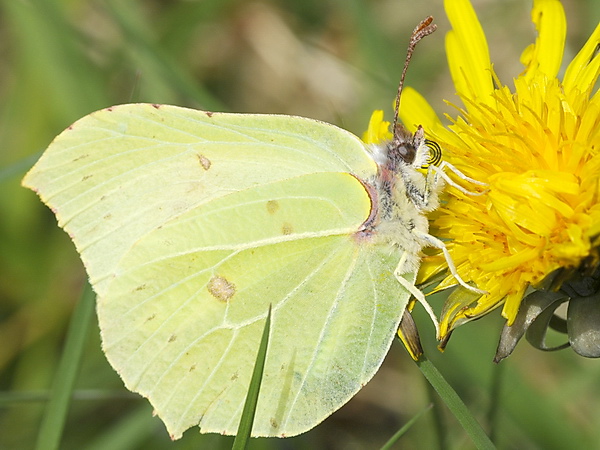 This is the elegant and quite rare Brimstone Butterfly feeding on Dandelions. This is the elegant and quite rare Brimstone Butterfly feeding on Dandelions.
This is rare in Leitrim but does occur in good numbers every year at Derrycarne Forest Park near Dromod.
It is dependent on the presence of Alder Buckthorn as the food plant for the Catterpillars.
We know of no records of this species from Lough Allen apart from at Drumkeelin south of Drumshanbo.
We would be interested in any sightings of this Butterfly or of Alder Buckthorn in the area.
(CONTACT us.)
|
|
|
For more on this Species and good images
of Alder Buckthorn leaves and berries please
go to Butterfly Conservation Ireland.
|
Here, we are planting Alder Buckthorn, a little known Irish tree, in our field. Over our heads you can see a patch of water. This is Drumkeelin Lough where we have seen a Brimstone Butterfly! We have not noticed any Alder Buckthorn in the area so are planting trees to see if we can attract this elusive species.
|
|
Out and About in Early Spring:
The Brimstone is an early Butterfly, out and active in good weather in March. However, before that our Birds will be returning to Lough Allen. The Mergansers from Donegal Bay, maybe, and the Common Sandpipers from southern Africa. Along with all the other species that are Summer visitors to Lough Allen. This is a quiet time of the year but we are waiting expectantly for things to jump into life. It is a time when weather varies enormously and you get good days and bad ones. We have been taking the opportunity of some of those good days to monitor the migration of birds into the area.
|
|
|
|
|
|
|
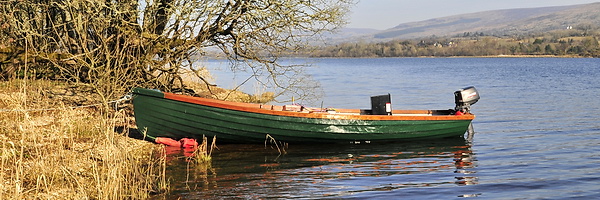
“A beautiful early Spring day on Lough Allen. Lake flat calm and our boat gets its first trip out of the year...
This was mainly a back-up trip to confirm what our shore journeys had indicated... that most of the Winter water birds were declining and that the Summer breeders had not yet arrived. Very small numbers of Wigeon, Teal and Tufted Ducks were spotted.
Bit it’s days like these that make all the work worthwhile...
Lough Allen is truely a glorious place!”
|
|
|
Red-breasted Merganser.
These are one of our most cherished species. They are a sea duck in Winter and return to large western lakes to breed in the early Spring. LoughAllenBasin.com with the help of SligoBirding and the many supporters of that Site, has been trying to track the movement of this species into Lough Allen
We suggested above that the Lough Allen population may come from the population of Ducks that winters in the Donegal Bay area. We have no proof of this! With the help of Birdline we are trying to link the disappearance of Margansers from coastal locations and their appearance in Lough Allen. This would be a clear indication of direct migration.
To date, they have not reached Lough Allen but we have had reports of parties and courting groups from Ballysadare, Lough Gill and Easkey Lough. We have undertaken a fairly complete survey of Lough Allen on March 2nd and 4th and have marked them... absent so far!
Lapwings (Right)
But we found Lapwings, just 2 hiding out on a remote skerry but near to possible breeding areas.
|
|
|
|
|
|
|
|
|
Migrating Winter Birds:
While Lough Allen does not hold large populations of Whooper Swans for long periods, some of the nearby secluded lakes encourage such flocks to drop by on their way north to breed in Iceland.
It is always a joy to hear and see these emotional and majestic transoceanic flyers dropping into our local ‘pond’.
The brown necks on these Whooper Swans is due to feeding among the roots of water plants on the shore of Drumkeelin Lough
|
|
|
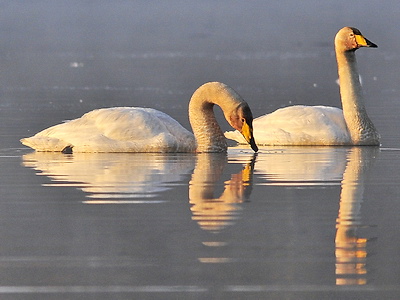 Our Winter Bird Count of Lough Allen as part of iWEBS produced the following numbers on 12th December 2010: Our Winter Bird Count of Lough Allen as part of iWEBS produced the following numbers on 12th December 2010:
Mallard 52; Teal 43; Tufted Duck 12, Wigeon 6
Cormorant 2;Great Crested Grebe 8; Heron 2; Mute Swan
Lapwing 5; Snipe 2; Curlew 3; Greenshank 2; Redshank 2
Bl-headed Gulls 34; Dipper 1; Kingfisher 2
(We also saw 35 Wigeon and 19 Whoopers on Nov. 22nd.)
Most of these are now gone but there are active small parties of Tufted Ducks (Right) seen on Lough Allen and neighbouring smaller lakes. This species breeds in the west of Ireland but it is not known to breed in Lough Allen. However it, and other ducks, do seem to be increasing in numbers. Dabbling ducks, like these are put at a disadvantage when rising water makes it harder for them to reach food on the bottom of the Lake.
|
|
|
Finally, in this section we want to include these photographs of displaying Goldeneye taken at Lough Meelagh to the west of Lough Allen. This species has been present for most of the Winter in small numbers in Lough Allen. It particularly likes secluded bays and inlets such as at Annagh Lough and the Rossmore area of Lough Allen.
These are a spectacular species but one which has left the area now on migration to breeding grounds further north. This is a Northern Asia and North American species that has comparitively recently started to breed in several European countries and has bred in Scotland since 1970. One pair bred in Lough Neagh in 2000, the first breeding recod for Ireland. It does seem to be increasing as a wintering duck in this area over the past few years.
|
Male and Female Goldeneye courting...
|
Three males chasing... a female Goldeneye!
|
|
|
LoughAllen Basin
Work Schedule for 2011
Last year we sought to catch up on Plants and Birds. Combined with a detailed depth analysis for possible investigation of the elusive Pollan (not yet published).
This years goals:
1: Continure monitoring rare species.
2: Locate likely areas for Pollan.
3. Let’s not forget our Mammals. (Squirrel from Larch woods south of Drumshanbo)
4. Water quality and sediment checking for indicators of Pollution.
5. Produce more and better high quality Artwork for Libraries and Schools.
6: Continue to Promote the idea of a Nature reserve for Lough Allen and support for an EU LIFE+ scheme!
7: Advance ideas for Conservation, indigenous sustainable Energy Sources, and local Employment
|
|
|
|
|
|
|
|
|

 Topical issues and natural
Topical issues and natural This is the elegant and quite rare Brimstone Butterfly feeding on Dandelions.
This is the elegant and quite rare Brimstone Butterfly feeding on Dandelions.
